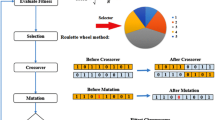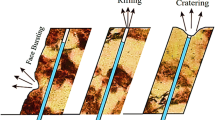Abstract
This research was aimed at developing a new model to predict flyrock distance based on a genetic programming (GP) technique. For this purpose, six granite quarry mines in the Johor area of Malaysia were investigated, for which various controllable blasting parameters were recorded. A total of 262 datasets consisting of six variables (i.e., powder factor, stemming length, burden-to-spacing ratio, blast-hole diameter, maximum charge per delay, and blast-hole depth) were collected applied to developing the flyrock predictive model. To identify the optimum model, several GP models were developed to predict flyrock. In the same way, using non-linear multiple regression (NLMR) analysis, various models were established to predict flyrock. Finally, to compare the performance of the developed models, regression coefficient (R 2), root mean square error (RMSE), variance account for (VAF), and simple ranking methods were computed. According to the results obtained from the test dataset, the best flyrock predictive model was found to be the GP based model, with R 2 = 0.908, RMSE = 17.638 and VAF = 89.917, while the corresponding values for R 2, RMSE and VAF for the NLMR model were 0.816, 26.194, and 81.041, respectively.














Similar content being viewed by others
References
Abhishek K, Panda BN, Datta S, Mahapatra SS (2014) Comparing predictability of genetic programming and ANFIS on drilling performance modeling for GFRP composites. Proc Mater Sci 6:544–550
Adhikari GR (1999) Studies on flyrock at limestone quarries. Rock Mech Rock Eng 32(4):291–301
Amini H, Gholami R, Monjezi M, Rahman Torabi S, Zadhesh J (2012) Evaluation of flyrock phenomenon due to blasting operation by support vector machine. Neural Comput Appl 21:2077–2085
Asadi M, Eftekhari M, Bagheripour MH (2011) Evaluating the strength of intact rocks through genetic programming. Appl Soft Comput 11(2):1932–1937
Bahrami A, Monjezi M, Goshtasbi K, Ghazvinian A (2011) Prediction of rock fragmentation due to blasting using artificial neural network. Eng Comput 27(2):177–181
Bajpayee TS, Rehak TR, Mowrey GL, Ingram DK (2004) Blasting injuries in surface mining with emphasis on flyrock and blast area security. J Safe Res 35(1):47–57
Baykasoglu A, Güllü H, Anakc HC, Özbakır L (2008) Prediction of compressive and tensile strength of limestone via genetic programming. Expert Syst Appl 35:111–123
Bhandari S (1997) Engineering rock blasting operations. Taylor & Francis, Boca Raton
Chiapetta RF, Bauer A, Dailey PJ, Burchell SL (1983) The use of high-speed motion picture photography in blast evaluation and design. In: Proceedings of 9th conference on explosives and blasting techniques. Dallas, TX, pp 31–40
Ebrahimi E, Monjezi M, Khalesi MR, Jahed Armaghani D (2015) Prediction and optimization of back-break and rock fragmentation using an artificial neural network and a bee colony algorithm. Bull Eng Geol Environ. doi:10.1007/s10064-015-0720-2
Faradonbeh RS, Monjezi M, Jahed Armaghani D (2015) Genetic programing and non-linear multiple regression techniques to predict backbreak in blasting operation. Eng Comput 32:123–133. doi:10.1007/s00366-015-0404-3
Faramarzi F, Mansouri H, Farsangi MAE (2014) Development of rock engineering systems-based models for flyrock risk analysis and prediction of flyrock distance in surface blasting. Rock Mech Rock Eng 47(4):1291–1306
Fletcher LR, D’Andrea DV (1987) Reducing accident through improved blasting safety. USBM IC, 9135. In: Proceedings of Bureau of Mines Technology Transfer Seminar. Chicago, pp 6–18
Ghasemi E, Sari M, Ataei M (2012) Development of an empirical model for predicting the effects of controllable blasting parameters on flyrock distance in surface mines. Int J Rock Mech Min Sci 52:163–170
Ghasemi E, Amini H, Ataei M, Khalokakaei R (2014) Application of artificial intelligence techniques for predicting the flyrock distance caused by blasting operation. Arab J Geosci 7(1):193–202
Hajihassani M, Jahed Armaghani D, Marto A, Tonnizam Mohamad E (2014) Ground vibration prediction in quarry blasting through an artificial neural network optimized by imperialist competitive algorithm. Bull Eng Geol Environ 74:873–886. doi:10.1007/s10064-014-0657-x
Hasanipanah M, Jahed Armaghani D, Khamesi H, Amnieh HB, Ghoraba S (2015) Several non-linear models in estimating air-overpressure resulting from mine blasting. Eng Comput. doi:10.1007/s00366-015-0425-y
Institute of Makers of Explosives (IME) Glossary of commercial explosive industry terms. Safety Publication, Washington DC: Institute of Makers of Explosives 1997. No 12, pp 16
ISRM (2007) In: Ulusay and Hudson (eds) The complete ISRM suggested methods for rock characterization, testing and monitoring: 1974–2006. Suggested methods prepared by the commission on testing methods, International Society for Rock Mechanics
Jahed Armaghani D, Mohamad ET, Hajihassani M, Abad SANK, Marto A, Moghaddam MR (2015a) Evaluation and prediction of flyrock resulting from blasting operations using empirical and computational methods. Eng Comput 32:109–121. doi:10.1007/s00366-015-0402-5
Jahed Armaghani D, Hajihassani M, Monjezi M, Mohamad ET, Marto A, Moghaddam MR (2015b) Application of two intelligent systems in predicting environmental impacts of quarry blasting. Arab J Geosci 8:9647–9665. doi:10.1007/s12517-015-1908-2
Jahed Armaghani D, Mohamad ET, Momeni E, Narayanasamy MS (2015c) An adaptive neuro-fuzzy inference system for predicting unconfined compressive strength and Young’s modulus: a study on Main Range granite. Bull Eng Geol Environ 74:1301–1319
Khandelwal M, Monjezi M (2013) Prediction of flyrock in open pit blasting operation using machine learning method. Int J Min Sci Technol 23(3):313–316
Khandelwal M, Singh TN (2007) Evaluation of blast-induced ground vibration predictors. Soil Dyn Earthq Eng 27(2):116–125
Khandelwal M, Singh TN (2009) Prediction of blast-induced ground vibration using artificial neural network. Int J Rock Mech Min Sci 46(7):1214–1222
Koza JR (1992) Genetic programming: on the programming of computers by means of natural selection. MIT Press, Cambridge, MA
Liong SY, Gautam TR, Khu ST, Babovic V, Keijzer M, Muttil N (2002) Genetic programming, a new paradigm in rainfall runoff modeling. J Am Water Resour Assoc 38(3):705–718
Little TN, Blair DP (2010) Mechanistic Monte Carlo models for analysis of flyrock risk. Rock fragmentation by blasting. Taylor and Francis, London, pp 641–647
Looney CG (1996) Advances in feed-forward neural networks: demystifying knowledge acquiring black boxes. IEEE Trans Knowl Data Eng 8(2):211–226
Lundborg N, Persson N, Ladegaard-Pedersen A, Holmberg R (1975) Keeping the lid on flyrock in open pit blasting. Eng Min J 176:95–100
Marto A, Hajihassani M, Jahed Armaghani D, Tonnizam Mohamad E, Makhtar AM (2014) A novel approach for blast-induced flyrock prediction based on imperialist competitive algorithm and artificial neural network. Sci World J 643715
McKenzie CK (2009) Flyrock range and fragment size prediction. http://docs.isee.org/ISEE/Support/Proceed/General/09GENV2/09v206g.pdf
Monjezi M, Bahrami A, Yazdian Varjani A (2010) Simultaneous prediction of fragmentation and flyrock in blasting operation using artificial neural networks. Int J Rock Mech Min Sci 47(3):476–480
Monjezi M, Bahrami A, Varjani AY, Sayadi AR (2011) Prediction and controlling of flyrock in blasting operation using artificial neural network. Arab J Geosci 4:421–425
Monjezi M, Khoshalan HA, Varjani AY (2012) Prediction of flyrock and backbreak in open pit blasting operation: a neurogenetic approach. Arab J Geosci 5(3):441–448
Monjezi M, Mehrdanesh A, Malek A, Khandelwal M (2013) Evaluation of effect of blast design parameters on flyrock using artificial neural networks. Neural Comput Appl 23(2):349–356
Nelson M, Illingworth WT (1990) A practical guide to neural nets. Addison-Wesley, Reading MA
Raina AK, Chakraborty AK, More R, Choudhury PB (2006) Design of factor of safety based criterion for control of flyrock/throw and optimum fragmentation. J Inst Eng (India) 87:13–17
Raina AK, Murthy VMSR, Soni AK (2014) Flyrock in bench blasting: a comprehensive review. Bull Eng Geol Environ 73:1199–1209. doi:10.1007/s10064-014-0588-6
Rezaei M, Monjezi M, Yazdian Varjani A (2011) Development of a fuzzy model to predict flyrock in surface mining. Safe Sci 49(2):298–305
Roth JA (1979) A model for the determination of flyrock range as a function of shot condition. US department of commerce. NTIS report no. PB81222358
Roy PP (1993) Putting ground vibration predictors into practice. Colliery Guard 241:63–67
Roy PP (2005) Rock blasting effects and operations. Taylor & Francis, Boca Raton
SPSS (2007) SPSS for Windows (Version 16.0). SPSS, Chicago
Swingler K (1996) Applying neural networks: a practical guide. Academic, New York
Tonnizam Mohamad E, Jahed Armaghani D, Hajihassani M, Faizi K, Marto A (2013) A simulation approach to predict blasting-induced flyrock and size of thrown rocks. Electron J Geotech Eng 18:365–374
Tonnizam Mohamad E, Jahed Armaghani D, Hasanipanah M, Murlidhar BR, Alel MNA (2016) Estimation of air-overpressure produced by blasting operation through a neuro-genetic technique. Environ Earth Sci 75(2):174
Trivedi R, Singh TN, Raina AK (2014) Prediction of blastinduced flyrock in Indian limestone mines using neural networks. J Rock Mech Geotech Eng 6(5):447–454
Trivedi R, Singh TN, Gupta N (2015) Prediction of blast-induced flyrock in opencast mines using ANN and ANFIS. Geotech Geol Eng 33:875–891. doi:10.1007/s10706-015-9869-5
Yagiz S, Gokceoglu C, Sezer E, Iplikci S (2009) Application of two non-linear prediction tools to the estimation of tunnel boring machine performance. Eng Appl Artif Intel. 22(4):808–814
Zorlu K, Gokceoglu C, Ocakoglu F, Nefeslioglu HA, Acikalin S (2008) Prediction of uniaxial compressive strength of sandstones using petrography-based models. Eng Geol 96(3):141–158
Author information
Authors and Affiliations
Corresponding author
Rights and permissions
About this article
Cite this article
Faradonbeh, R.S., Jahed Armaghani, D. & Monjezi, M. Development of a new model for predicting flyrock distance in quarry blasting: a genetic programming technique. Bull Eng Geol Environ 75, 993–1006 (2016). https://doi.org/10.1007/s10064-016-0872-8
Received:
Accepted:
Published:
Issue Date:
DOI: https://doi.org/10.1007/s10064-016-0872-8




